fog light CADILLAC SEVILLE 1993 4.G Owners Manual
[x] Cancel search | Manufacturer: CADILLAC, Model Year: 1993, Model line: SEVILLE, Model: CADILLAC SEVILLE 1993 4.GPages: 407, PDF Size: 22.28 MB
Page 18 of 407
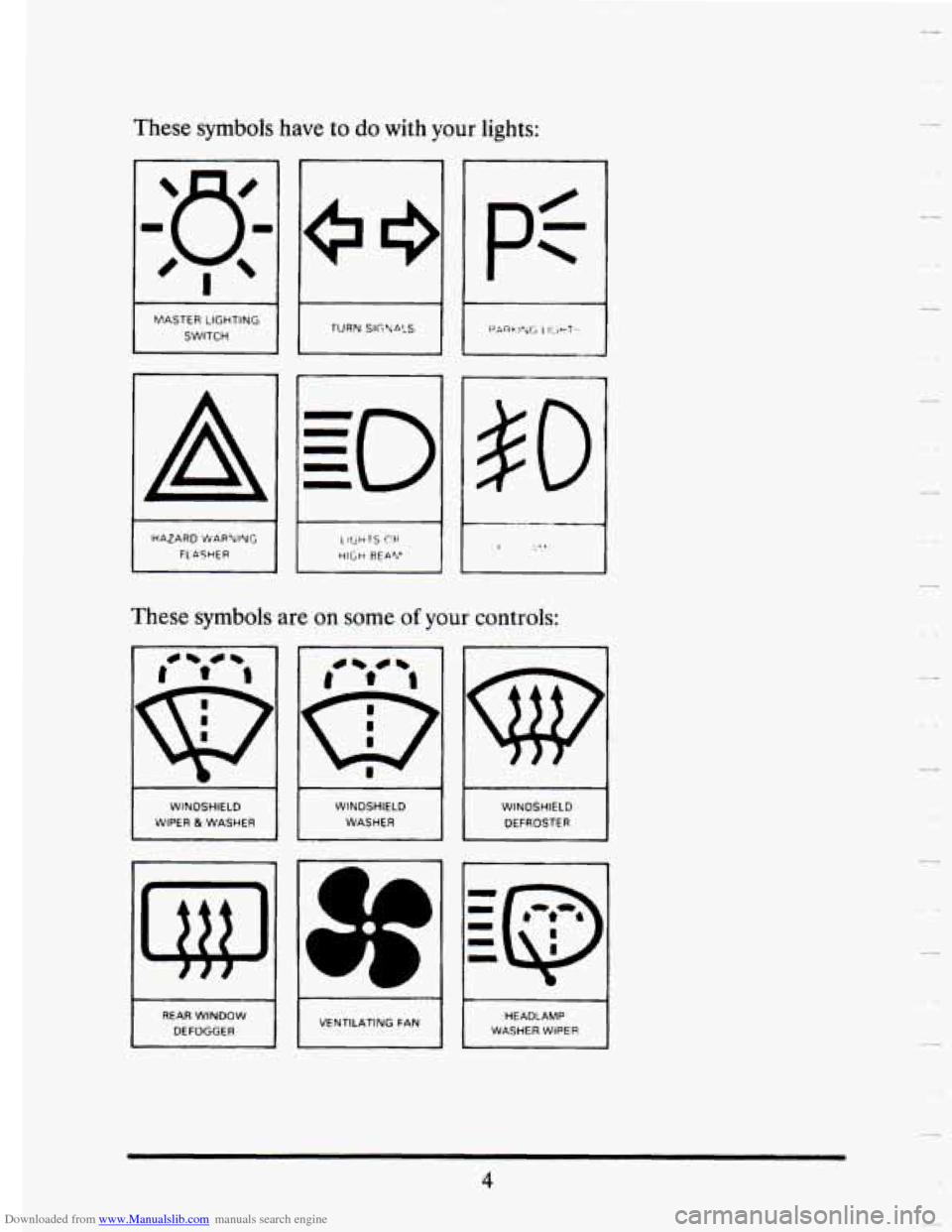
Downloaded from www.Manualslib.com manuals search engine These symbols have to do with your lights:
MASTER LIGHTING
SWITCH
A $0
HAZARD WARNIYG
FLASHER I
These symbols are on some of your controls:
Q
d- #b
WINDSHIELD
WIPER &WASHER
ww I
H
WINDSHIELD
DEFROSTER
WINDSHIELD WASHER I Y
u
I I
VENTILATING
FAN I
I
REAR WINDOW
DEFOGGER HEADLAMP
WASHER WIPER
4
Page 124 of 407
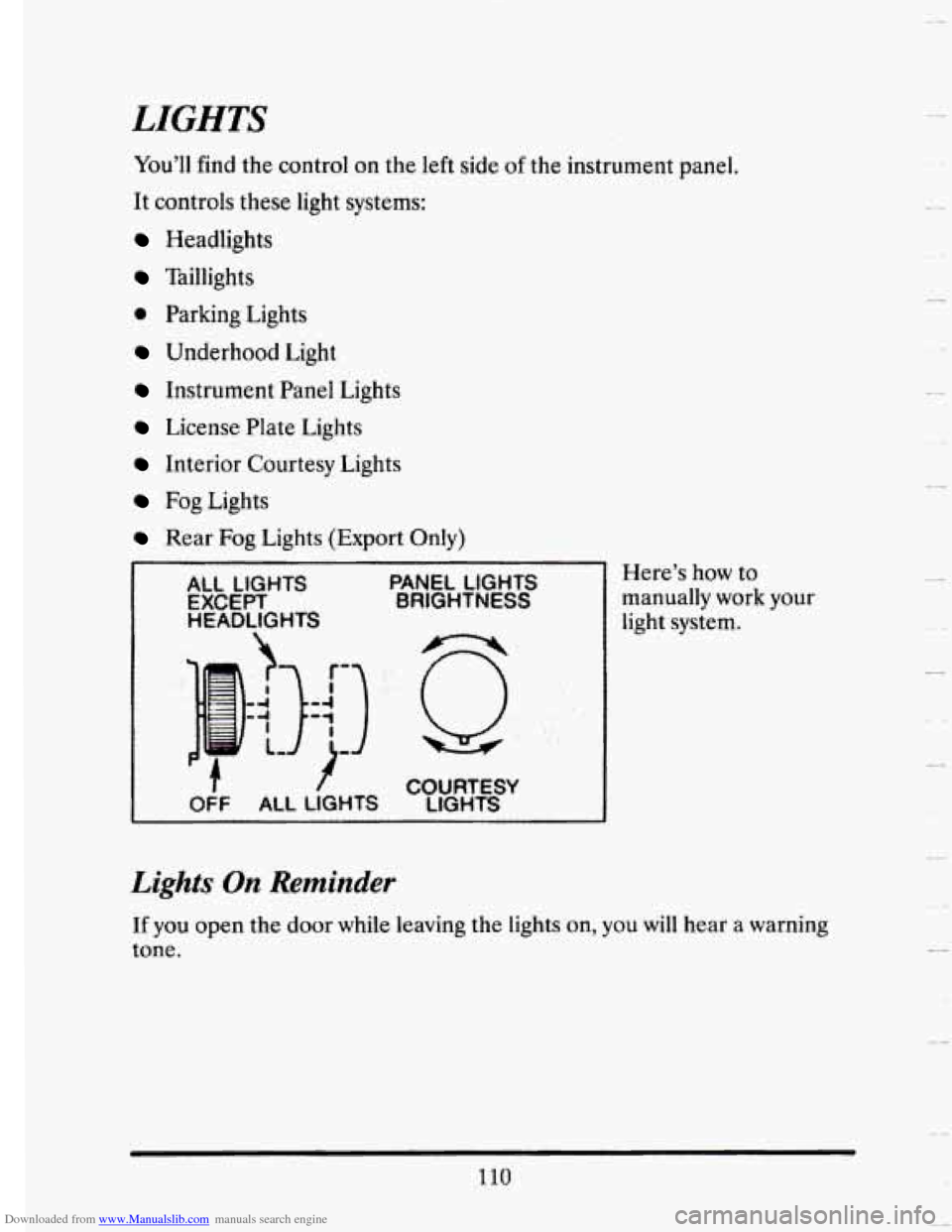
Downloaded from www.Manualslib.com manuals search engine LIGHTS
You’ll find the control on the left side of the instrument panel.
It controls these light systems:
Headlights
Taillights
0 Parking Lights
Underhood Light
Instrument Panel Lights
License Plate Lights
Interior Courtesy Lights
Fog Lights
Rear Fog Lights (Export Only)
ALL LIGHTS PANEL LIGHTS
EXCEPT BRIGHTNESS
HEADLIGHTS
COURTESY
LIGHTS
Here’s how to
manually work
your
light system.
Lights On Reminder
If you open the door while leaving the lights on, you will hear a warning
tone.
110
Page 125 of 407

Downloaded from www.Manualslib.com manuals search engine Twilight Sentinel
I
The control is next to the headlight switch. It switches your lights on and
off by sensing how dark it is outside. To operate it, leave the light switch
off and move the control to any position but off.
If you move the control all the way to MAX, your lights will remain on for
90 seconds after you turn your engine off. If you move the control almost
all the way in the other direction,
so it is just on, the lights will go off
quickly when you turn off your engine. You can change this delay time
from
only a few seconds to 90 seconds.
Operation of Lights
Although your vehicle’s lighting system (headlamps, parking lamps, fog
lamps, side marker lamps and tail lamps) meet all applicable Federal
lighting requirements, certain States and Provinces may apply their own
lighting regulations that may require special attention before you operate
these lamps. For example, some jurisdictions may require that you
operate your lower beam lamps with fog lamps at all times, or that
headlamps be turned on whenever you must use your windshield wipers.
In addition, most jurisdictions prohibit driving solely with parking lamps,
especially at dawn or dusk.
It is recommended that you check with your
own State or Provincial highway authority for applicable lighting
regulations.
111
Page 126 of 407
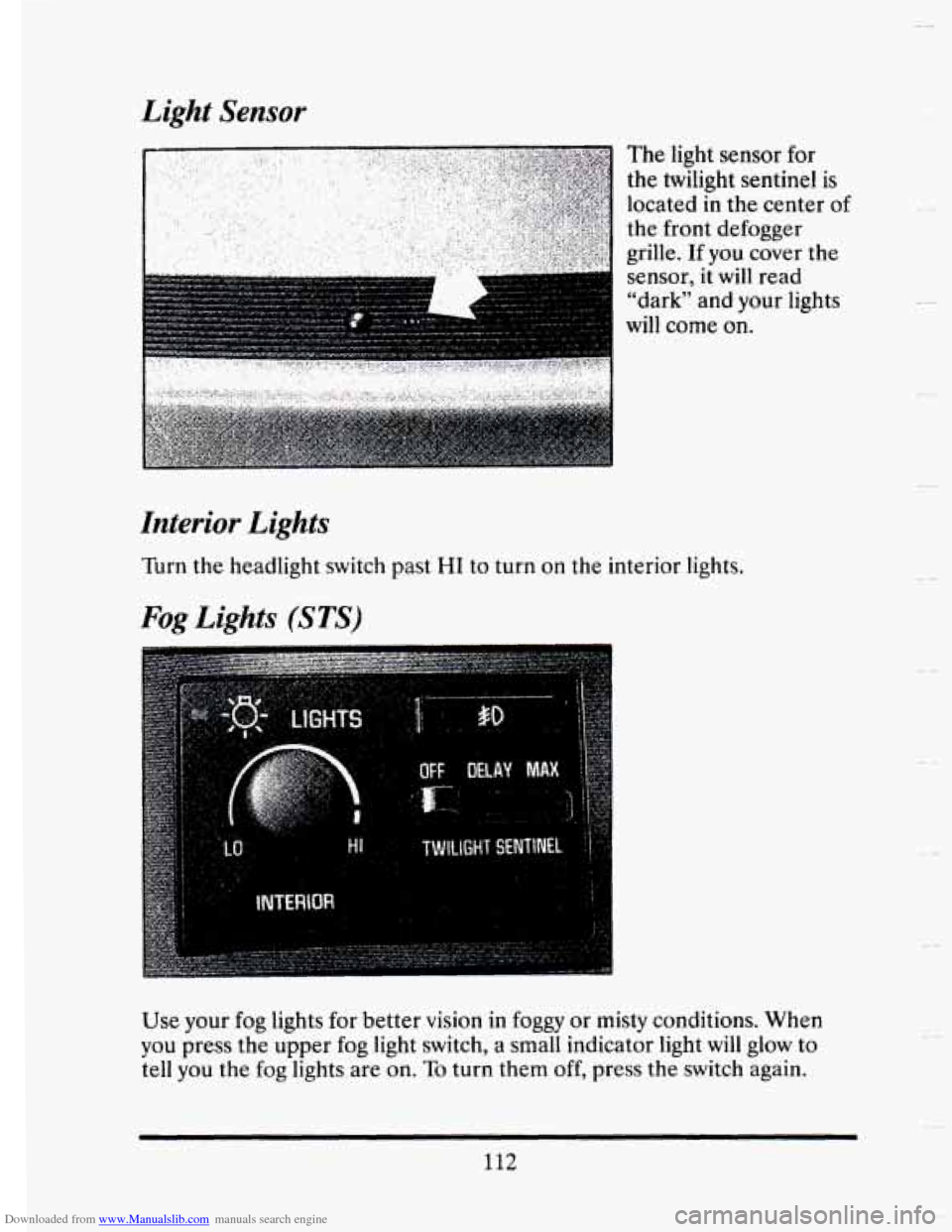
Downloaded from www.Manualslib.com manuals search engine Light Sensor
Interior Lights
Turn the headlight switch past HI to turn on the interior lights.
Fog Lights (STS)
Use your fog lights for better vision in foggy or misty conditions. When
you
press the upper fog light switch, a small indicator light will glow to
tell you the fog lights are on. To turn them off, press the switch again.
112
c
i
Page 127 of 407
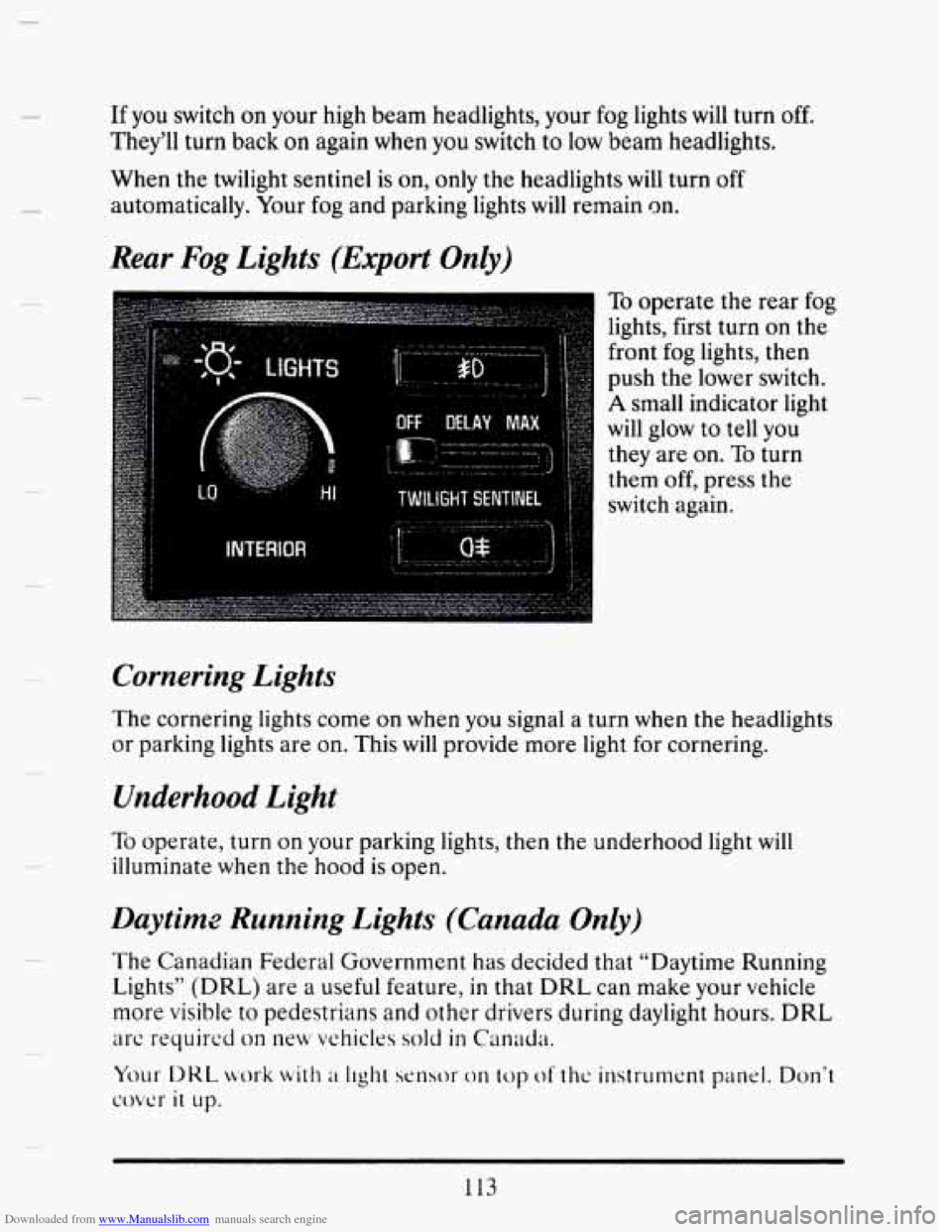
Downloaded from www.Manualslib.com manuals search engine If you switch on your high beam headlights, your fog lights will turn off.
They’ll turn back on again when you switch to low beam headlights.
When the twilight sentinel
is on, only the headlights will turn off
automatically. Your fog and parking lights will remain on.
Rear Fog Lights (Export Only)
To operate the rear fog
lights, first turn on the
front fog lights, then
push the lower switch.
A small indicator light
will glow to tell you
they are on.
To turn
them off, press the
switch again.
Cornering Lights
The cornering lights come on when you signal a turn when the headlights
or parking lights are
on. This will provide more light for cornering.
Underhood Light
To operate, turn on your parking lights, then the underhood light will
illuminate when the hood
is open.
Daytims Running Lights (Canada Only)
The Canadian Federal Government has decided that “Daytime Running
Lights” (DRL) are a useful feature,
in that DRL can make your vehicle
more visible to pedestrians and other drivers during daylight hours.
DRL
arc required on new vehicles sold in Canada.
Your DKL nw-k with ;I Ilght sensor on top of thc instrument panel. Don’t
covcr it up.
113
Page 152 of 407
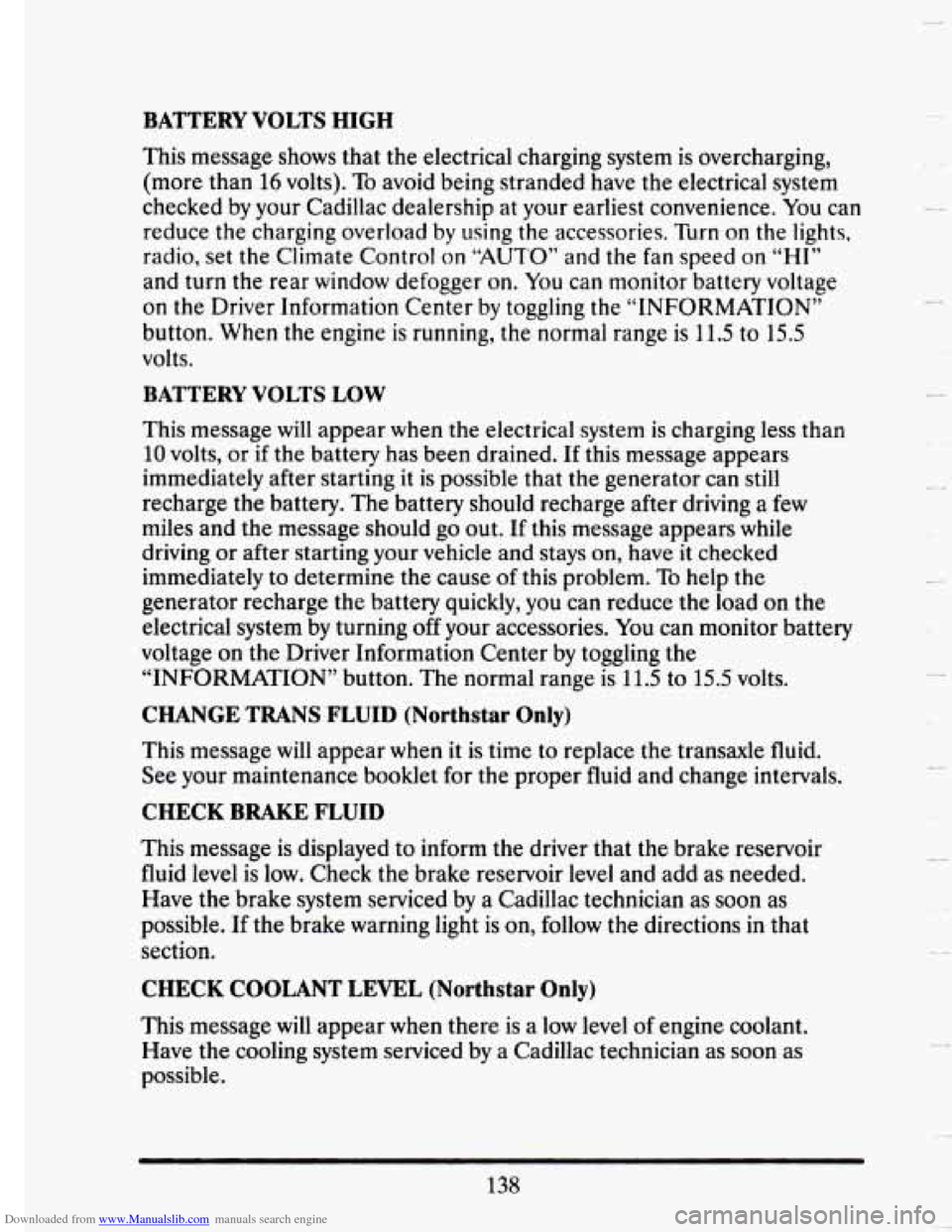
Downloaded from www.Manualslib.com manuals search engine BATTERY VOLTS HIGH
This message shows that the electrical charging system is overcharging,
(more than 16 volts). To avoid being stranded have the electrical system
checked by your Cadillac dealership at your earliest convenience. You can
reduce the charging overload
by using the accessories. Turn on the lights,
radio, set the Climate Control on
“AUTO” and the fan speed on “HI”
and turn the rear window defogger on. You can monitor battery voltage
on the Driver Information Center by toggling the “INFORMATION”
button. When the engine is running, the normal range
is 11.5 to 15.5
volts.
c
BATTERY VOLTS LOW
This message will appear when the electrical system is charging less than
10 volts, or if the battery has been drained. If this message appears
immediately after starting it is possible that the generator can still
recharge the battery. The battery should recharge after driving a few
miles and the message should go out. If this message appears while
driving or after starting your vehicle and stays on, have it checked
immediately to determine the cause
of this problem. To help the
generator recharge the battery quickly,
you can reduce the load on the
electrical system by turning
off your accessories. You can monitor battery
voltage on the Driver Information Center by toggling the
“INFORMATION’’ button. The normal range is
11.5 to 15.5 volts.
CHANGE TRANS FLUID (Northstar Only)
This message will appear when it is time to replace the transaxle fluid.
See your maintenance booklet
for the proper fluid and change intervals.
CHECK BRAKE FLUID
This message is displayed to inform the driver that the brake reservoir
fluid level is low. Check the brake reservoir level and add as needed.
Have the brake system serviced by a Cadillac technician as soon as
possible.
If the brake warning light is on, follow the directions in that
section.
CHECK COOLANT LEVEL (Northstar Only)
This message will appear when there is a low level of engine coolant.
Have the cooling system serviced by a Cadillac technician as soon as
possible.
138
I
. -’
L
c
Page 209 of 407
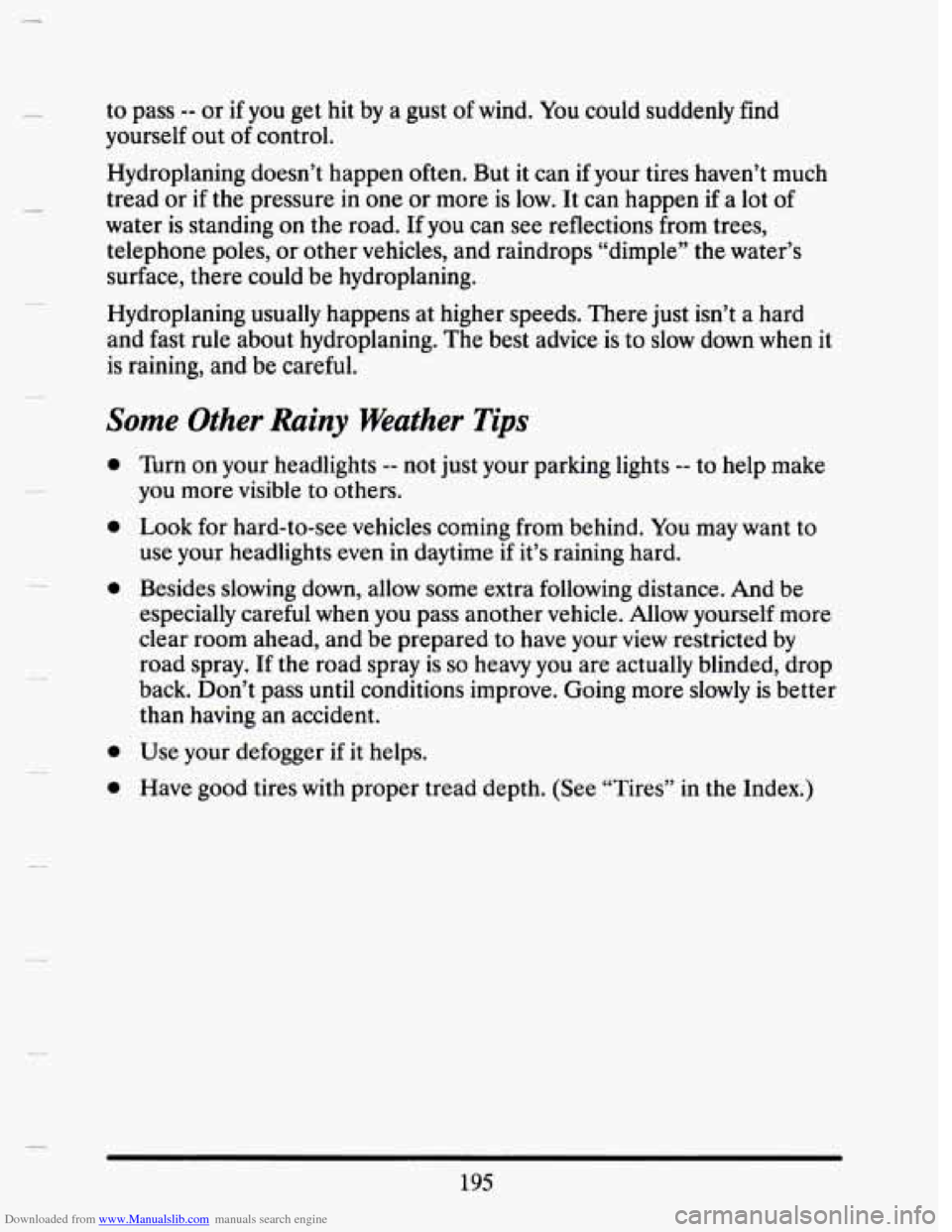
Downloaded from www.Manualslib.com manuals search engine to pass -- or if you get hit by a gust of wind. You could suddenly find
yourself out of control.
Hydroplaning doesn’t happen often. But it can
if your tires haven’t much
tread or
if the pressure in one or more is low. It can happen if a lot of
water is standing
on the road. If you can see reflections from trees,
telephone poles, or other vehicles, and raindrops “dimple” the water’s
surface, there could be hydroplaning.
Hydroplaning usually happens at higher speeds. There just isn’t a hard
and fast rule about hydroplaning. The best advice is to slow down when it
is raining, and be careful.
Some Other Rainy Weather Tips
a
a
a
a
a
Turn on your headlights -- not just your parking lights -- to help make
you more visible to others.
Look for hard-to-see vehicles coming from behind. You may want to
use your headlights even
in daytime if it’s raining hard.
Besides slowing down, allow some extra following distance. And \
be
especially careful when you pass another vehicle. Allow yourself more
clear room ahead, and be prepared
to have your view restricted by
road spray. If the road spray is so heavy you are actually blinded, drop
back. Don’t pass until conditions improve. Going more slowly \
is better
than having an accident.
Use your defogger
if it helps.
Have good tires
with proper tread depth. (See “Tires” in the Index.)
195
Page 210 of 407
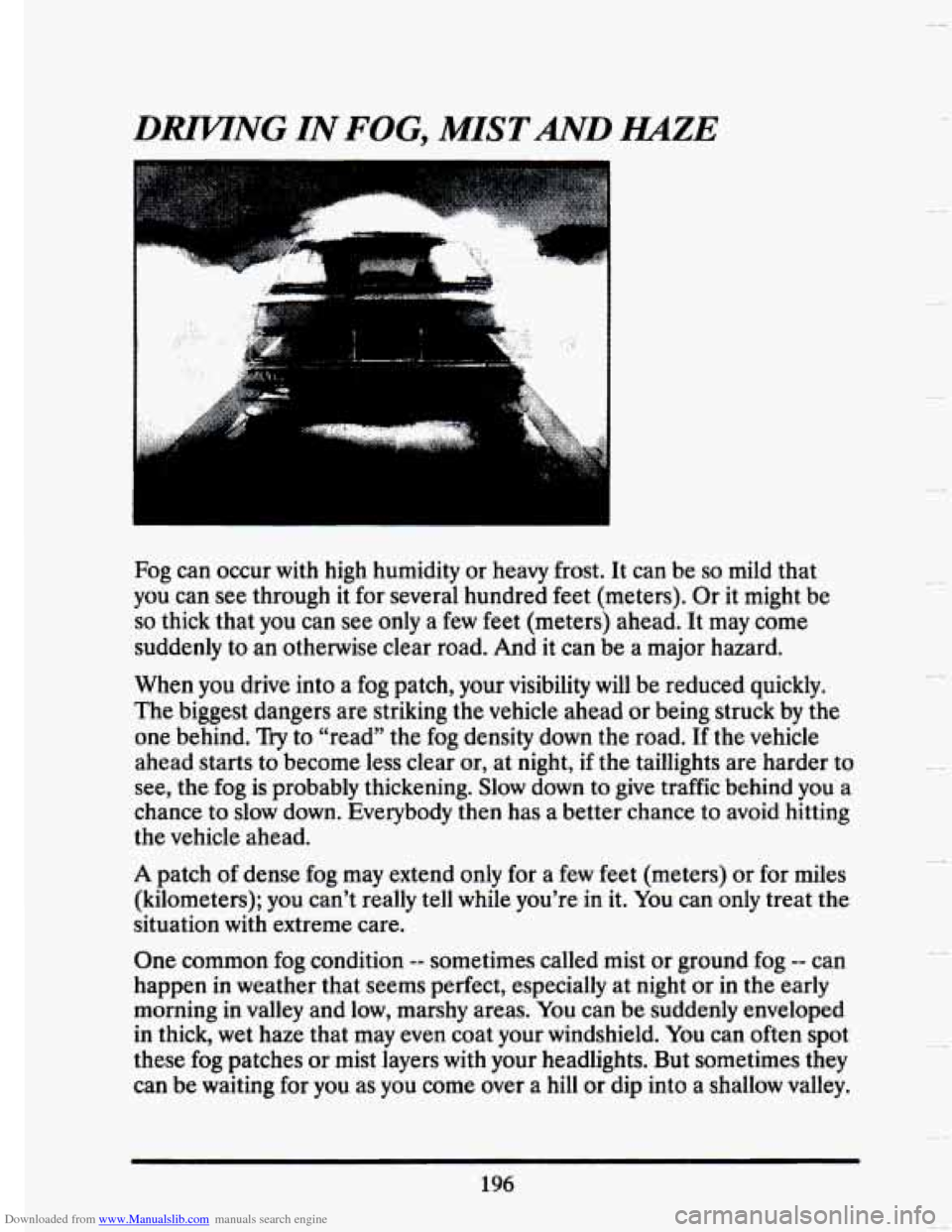
Downloaded from www.Manualslib.com manuals search engine DRIVING IN FOG, MISTAND HAZE
Fog can occur with high humidity or heavy frost. It can be so mild that
you can see through it for several hundred feet (meters). Or it might be
so thick that you can see only a few feet (meters) ahead. It may come
suddenly to an otherwise clear road. And it can be a major hazard.
When you drive into a fog patch, your visibility will be reduced quickly.
The biggest dangers are striking the vehicle ahead or being struck by the
one behind.
Try to "read" the fog density down the road. If the vehicle
ahead starts to become less clear or, at night,
if the taillights are harder to
see, the fog is probably thickening. Slow down to give traffic behind you' a
chance to slow down. Everybody then has a better chance to avoid hitting
the vehicle ahead.
A patch of dense fog may extend only for a few feet (meters) or for miles
(kilometers); you can't really tell while you're
in it. You can only treat the
situation with extreme care.
One common fog condition
-- sometimes called mist or ground fog -- can
happen
in weather that seems perfect, especially at night or in the early
morning
in valley and low, marshy areas. You can be suddenly enveloped
in thick, wet haze that may even coat your windshield.
You can often spot
these fog patches or mist layers with your headlights. But sometimes they
can be waiting for you as you come over a
hill or dip into a shallow valley.
196
c
Page 211 of 407
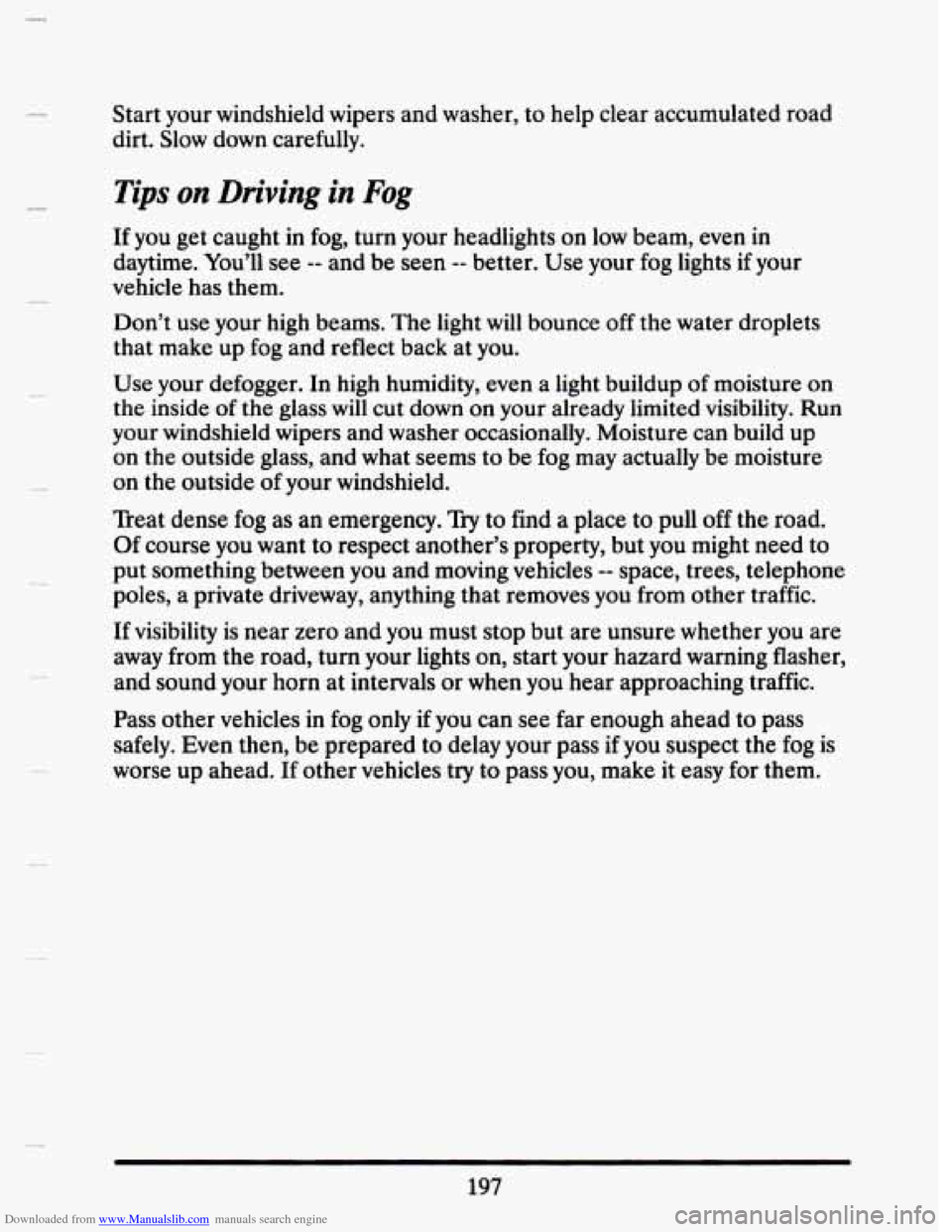
Downloaded from www.Manualslib.com manuals search engine Start your windshield wipers and washer, to help clear accumulated road
dirt. Slow down carefully.
Tips on Driving in Fog
If you get caught in fog, turn your headlights on low beam, even in
daytime. You’ll
see -- and be seen -- better. Use your fog lights if your
vehicle has them.
Don’t use your high beams. The light will bounce
off the water droplets
that make up fog and reflect back at you.
Use your defogger. In high humidity, even a light buildup of moisture
on
the inside of the glass will cut down on your already limited visibility. Run
your windshield wipers and washer occasionally. Moisture can build up
on the outside glass, and what seems
to be fog may actually be moisture
on the outside of your windshield.
Treat dense fog as an emergency.
Try to find a place to pull off the road.
Of course you want to respect another’s property, but you might need to
put something between
you and moving vehicles -- space, trees, telephone
poles,
a private driveway, anything that removes you from other traffic.
If visibility is near zero and you must stop but are unsure whether you are
away from the road, turn your lights on, start your hazard warning flasher,
and sound your horn at intervals or when you hear approaching traffic.
Pass other vehicles in fog
only if you can see far enough ahead to pass
safely. Even then, be prepared to delay your pass
if you suspect the fog is
worse up ahead.
If other vehicles try to pass you, make it easy for them.
197
Page 296 of 407
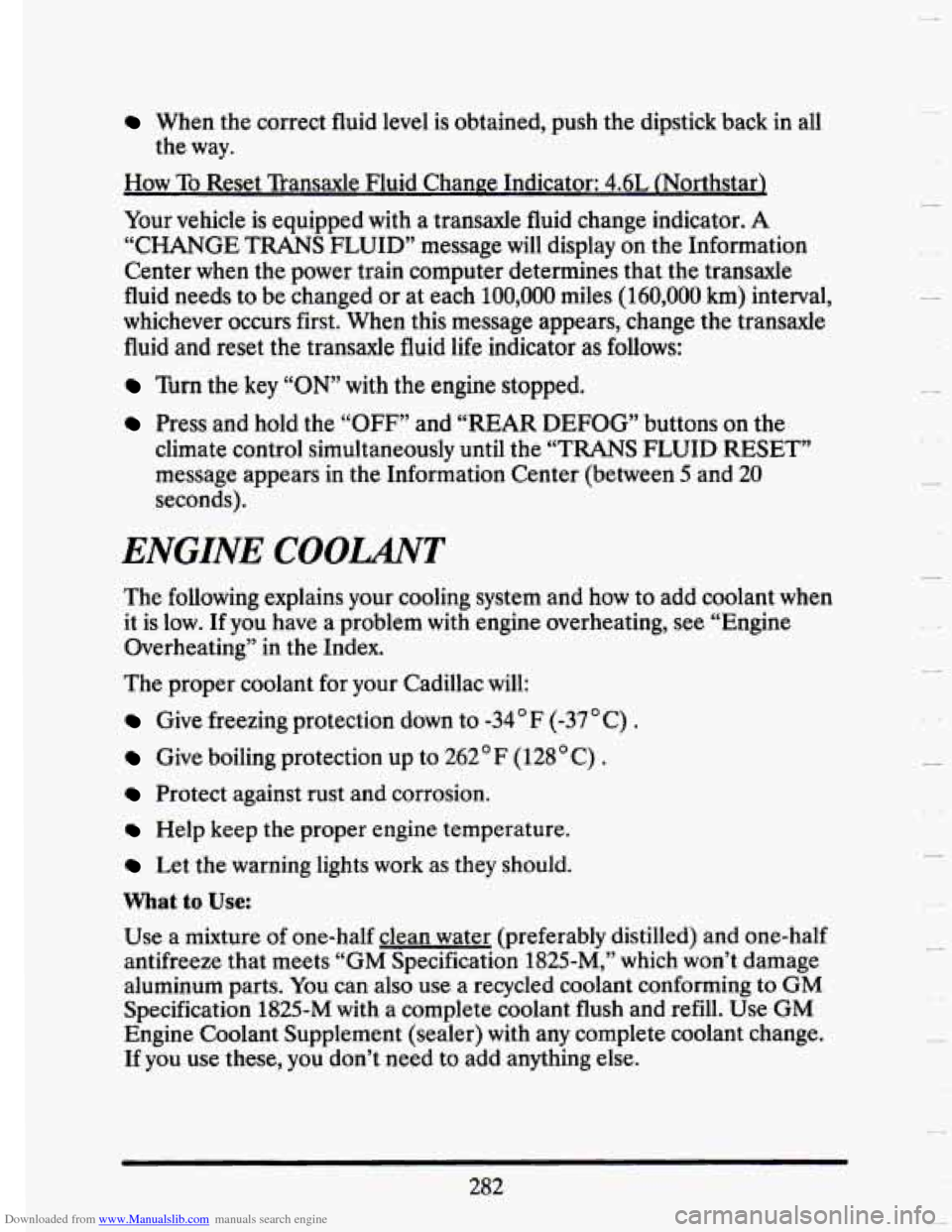
Downloaded from www.Manualslib.com manuals search engine When the correct fluid level is obtained, push the dipstick back in all
the way.
How To Reset Transaxle Fluid Change Indicator: 4.6L (Northstar)
Your vehicle is equipped with a transaxle fluid change indicator.
A
“CHANGE TRANS FLUID” message will display on the Information
Center
when the power train computer determines that the transaxle
fluid needs to be changed or at each 100,000 miles
(160,000 km) interval,
whichever occurs first. When this message appears, change the t\
ransaxle
fluid and reset the transaxle fluid life indicator
as follows:
Turn the key “ON” with the engine stopped.
Press and hold the “OFF” and “REAR DEFOG” buttons on the
climate control simultaneously
until the “TRANS FLUID RESET”
message appears
in the Information Center (between 5 and 20
seconds).
ENGINE COOLANT
The following explains your cooling system and how to add coolant when
it is low. If you have
a problem with engine overheating, see “Engine
Overheating” in the Index.
The proper coo’ It for
your Cadillac will:
Give freezing protection down to -34°F (-37’C) .
Give boiling protection up to 262 ” F (128 ” C) .
Protect against rust and corrosion.
Help keep the proper engine temperature.
Let the warning lights work as they should.
What to Use:
Use a mixture of one-half clean water (preferably distilled) and one\
-half
antifreeze that meets
“GM Specification 1825-M,” which won’t damage
aluminum parts. You can also use a recycled coolant conforming to
GM
Specification 1825-M with a complete coolant flush and refill. Use GM
Engine Coolant Supplement (sealer) with any complete coolant c\
hange.
If you use these, you don’t need to add anything else.
Y
c.
282